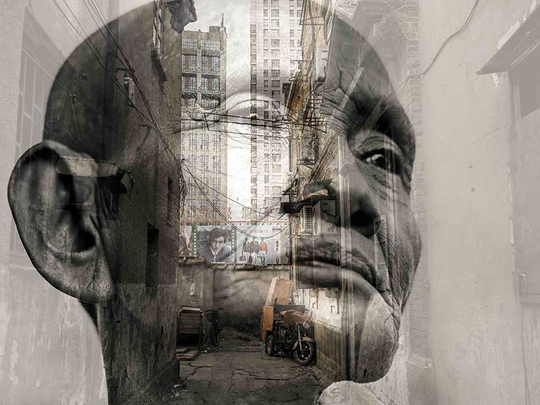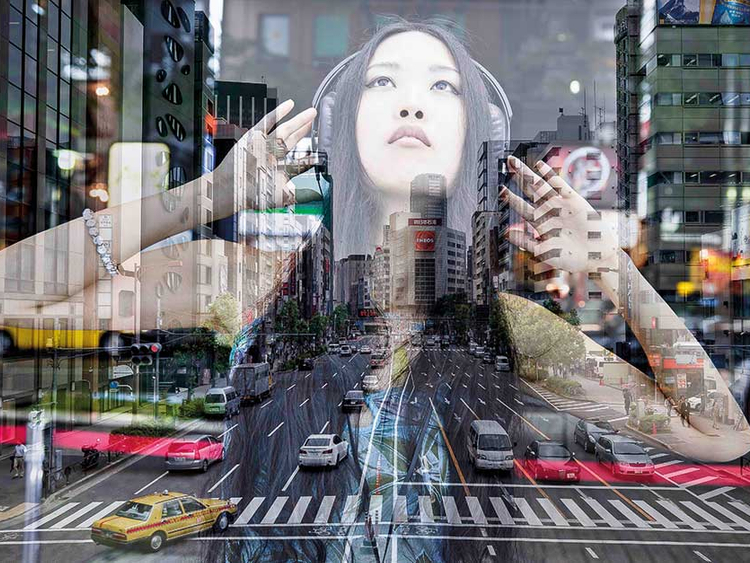
French photographer Boris Wilensky is well known for his portraits of hip-hop singers and professional boxers. But he now uses photography to create art that raises awareness about contemporary issues that are impacting our lives and our planet. In his first exhibition in the UAE, Hurban Vortex, Wilensky is presenting images from a project for which he was awarded the Prix du Jury Professionnel Paris Artistes in 2016. The Hurban Vortex project was inspired by two trips Wilensky made to Tokyo in 2009 and 2011, before and after the Fukushima disaster. It includes three distinct series, titled Origins, Collapse and Post, that speak about the long-term effect of excessive urbanisation on human beings and our planet.
The word Hurban in the title is a combination of the words ‘human’ and ‘urban’; and this blending is also echoed in the images, where the artist has superimposed portraits of people onto urban landscapes, to depict the fusion and friction between humanity and urbanisation. The show, curated by Okarys Art Leads, features selected images from all three series, inviting viewers to reflect on the place of human beings in a bruised ecosystem, but also holding out hope for a future where humanity triumphs over urbanisation.
“It is difficult to retain your humanity when you live in a big city. In this project, I used the ‘surimpression’ technique to superimpose portraits of people onto images of cities, which symbolise modernity and progress, to show how the two elements meet, connect and clash in the chaotic, turbulent vortex of the urban environment. I hope these artworks will make people stop and think about where we are headed, and what kind of future we want for ourselves and our planet,” Wilensky says.
The project was inspired by the difference he saw in Tokyo between his first visit in 2009, and the next one in 2011 after the Fukushima disaster. “On the first trip, I encountered a megalopolis that was overcrowded, immersed in the excess of limitless consumption, and bustling 24/7 with life and energy. But when I returned two years later the city seemed to be darker – figuratively and literally. There were fewer lights because of the impact of the disaster on the power grid, and there was a sadness on the faces of the people. For the first time, the Japanese people were out on the streets participating in massive demonstrations against nuclear energy. Something had changed in their minds, and they began questioning whether this kind of progress is good for them. Watching all this made me think about our blind faith in modernity and progress, which is making us less human, and about ways to visually depict the origin, consequence and future of this confrontation between humanity and urbanisation,” he says.
The first series in this project, Origins presents vignettes from daily life in a modern metropolis such as Tokyo. Images of tall skyscrapers, traffic jams, shops filled with consumer goods, and the bright lights of the city at night are juxtaposed with pictures of people of different ages going about their daily routines, such as commuting to work on the Metro, listening to music, or playing in the park. The colourful, composite images capture the sights, sounds and energy of Tokyo, that Wilensky experienced on his first visit.
The mood is different in the other two series. For this part of the project Wilensky travelled to Tokyo, Shanghai and Bangkok, cities that signify modernity to him, and took hundreds of photographs of the steel and glass buildings, congested streets, ubiquitous billboards, endless streams of vehicles, network of wires and cables running overhead, and dark, lonely underground parking lots. He then spent two months travelling on his motorcycle through the countryside in Cambodia, interacting closely with the people and immersing himself in the Khmer culture, returning with hundreds of portraits of ordinary Cambodians.
In the Collapse series, he has juxtaposed the urban background with images of Cambodians wearing cracked welding glasses and gas masks, which give the images a sinister feel.
“The concept behind this series was inspired by the Japanese mythological story of the Namazu – a giant catfish that causes earthquakes. According to this story the fish lives in the mud under the islands of Japan, and is kept in control by god Kashima, who restrains it with a stone. But when the god lets his guard down, the Namazu thrashes about causing violent earthquakes, and it is believed that someday this will lead to Japan being submerged underwater. Through these images I wanted to show that the constant competition between economy and ecology is leading us to a frightening future,” Wilensky says.
“I specially went to Cambodia for this series because I wanted portraits of people who are unaffected by city life, and have not lost their humanity. I spent time with each of my subjects, talking to them, telling them about the project and involving them in a collaborative process. It was a challenge for me to shoot portraits of people who had their eyes and faces covered, but the dehumanisation conveys a dire warning about the consequences of our mindless rush towards what we think is progress,” he adds.
The third part of the project, Post offers a more positive outlook. Here, the images in the background were shot in old areas of Shaghai that have been neglected and forgotten in the push for urban expansion, and construction of bigger and taller skyscrapers. The crumbling buildings and empty streets seem to be a fading memory of the past. But the portraits of people superimposed on this grey landscape are in sharp focus. You can see every line on the wizened faces, and the warmth and humanity in their eyes, as they look towards the future with a smile.
“The Post series is about a post-modern world in a faraway future when cities will cease to exist, and humanity will be more important than progress and urbanisation. As the earlier images show, today our identity dissolves at the heart of the tremendous, ever expanding urban and suburban spaces, but I hope in the future human beings will learn to live in harmony with the environment, and redefine our place in the natural world,” Wilensky says.
Jyoti Kalsi is an arts enthusiast based in Dubai
Hurban Vortex will run at La Galerie, Alliance Française Dubai on Oud Metha Road until September 15













